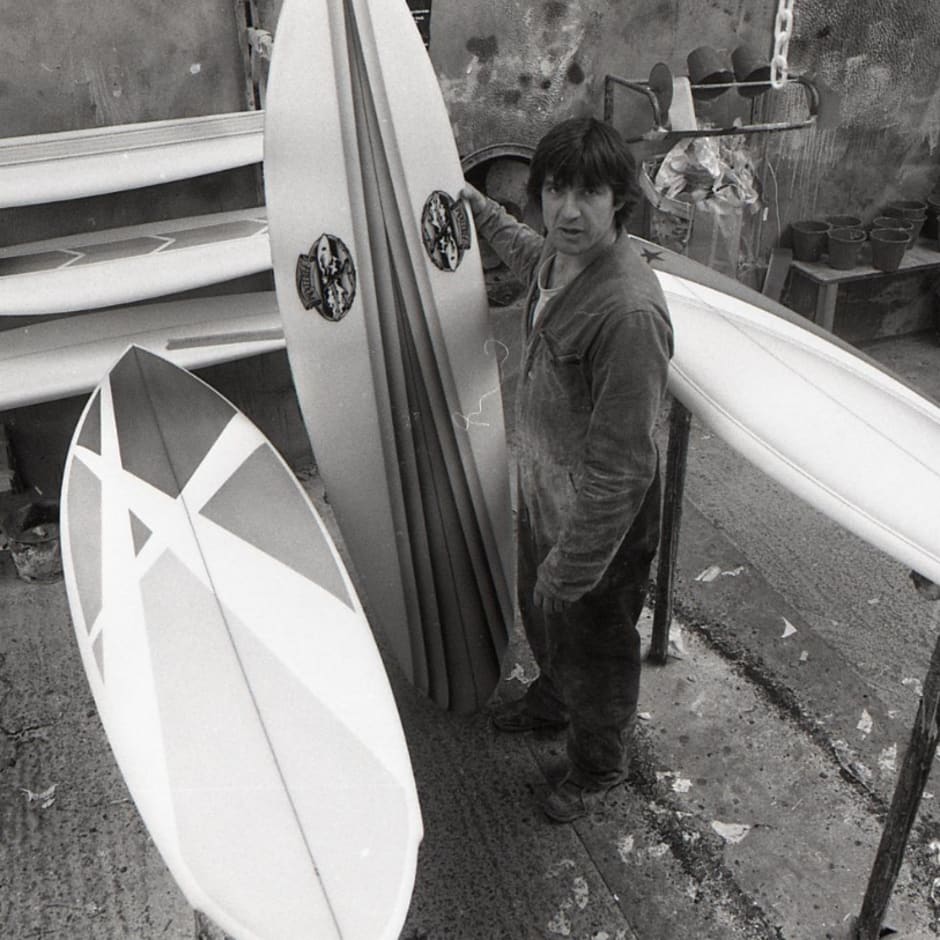
Jersey was introduced to surfing by Islander Nigel Oxenden in the 1920s, find out how the sport has developed and shaped Jersey's intangible cultural history.

The 1950s
After the War ended, Islanders could once again use the beaches. Swimmers and body boarders returned to the waves at St Ouen, but Jersey’s original surf club, the Island Surf School of Jersey, was not revived.
In 1958, however, South Africans workers arrived in Jersey! Three young labourers who had been working in London were lured to the Island by a tourism film showing the waves at St Ouen. They found work washing dishes at Parkin’s Holiday Camp at Plemont, and were astonished to discover that there was almost no surfing in Jersey. They built their own hollow wooden boards, took them down to St Ouen’s Bay, and a new age of surfing in Jersey dawned.
Harry Swanson, owner of the Watersplash nightclub in St Ouen’s Bay, promptly hired them as “South African Hawaiian Board Riders” and lifeguards, and tourists and locals flocked to watch them.
Locals were keen to try the new sport and began building surfboards from balsa and plywood. They quickly discovered you could do amazing things like stand up to ride the waves! However, their hollow wooden boards gradually filled with water so surfers had to empty them to drag them up the beach. Wetsuits were not yet in common use, so surfers wore bathing suits. This was fine in the warm waters of southern California and Hawaii, but in Jersey winter surfing was only for the very hardy.
In 1959, a group of young surfers formed the Jersey Surfboard Club. It is said to be the oldest surf club in Europe. It helped to turn surfing in Jersey from a sport with a few enthusiasts to an essential part of Island life – and it produced some champions along the way.
Image: The Jersey Surfboard Club was formed in 1959. Image by John Houiellebecq.

The 1960s and 70s
In the 1960s, the Jersey Surfboard Club started to put Jersey on the map. The first “Surf-Riding Championship” was held in St Ouen’s Bay in 1962, using the latest fibreglass “Malibu” boards.
From then on, Jersey rode the crest of the waves as a surfing hotspot, hosting European and international competitions. Surfers from California, Australia, Hawaii and Biarritz, as well as British surfers, all competed in Jersey. Big names such as Rodney Sumpter, the brilliant British-Australian champion, competed against local surfers in front of huge crowds. Local surfers travelled overseas to practise on different waves.
Competing surfers from Jersey did their Island proud. Surfers like Gordon Burgis, Barry Jenkins and Steve Harewood were tough competition for the international competitors and were often highly placed in contests. Gordon Burgis was the national champion surfer several times in the 1960s and also won the European title in 1969.
In 1968, three out of four of the British team at the World Surfing Championships were from Jersey, and the Island continued to be represented internationally throughout the 1970s.
But although the top Jersey surfers were competing at an international level, the local surfing scene was still characterised by a relaxed, friendly atmosphere.
Image: Many national and international surf competitions were held at the Watersplash in the 1960s. JEP collection held at Jersey Archive

Surfboard designs
From plywood planks to carbon fibre fins, surfboards have changed with the times, and Jersey has been right at the centre of new developments.
The giant wooden longboards only lasted a few years in Jersey. By the early 1960s, new “malibu” longboards were made of polyurethane foam and fibreglass. The new materials made the boards lighter and faster – and they didn’t fill with water!
By the early 1970s surfers were riding shortboards of about 6.5 feet long. These shorter boards revolutionised surfing with faster turns and easier handling.
Steve Harewood, one of Jersey’s champion surfers, started the Freedom surfboard company in 1973. He had travelled and surfed all over the world and Freedom designs were inspired by the latest in board technology from America. Freedom boards were exported all over Europe and were especially popular in Jersey.
Image: Steve Harweood at the Freedom Factory in 1981. JEP collection held at Jersey Archive

The 1980s and 90s
Surfing became big business in the 1980s. Surf wear became fashionable with non-surfers, and surf companies had great commercial success. Logos and labels were everywhere, with surf boards and clothing covered with them. In Jersey, surf businesses like Freedom started selling fashion as well as practical surf gear and suddenly found a lot of non-surfers among their customers.
Surfing was now a global sport and Jersey was no longer centre stage in the way that it had been twenty years earlier. However, standards were still high with young surfers representing their Island at international level.
At the World Surfing Championships in California in 1984, five members of the British team were from Jersey, including Arlene Maltman, a local surfer who had won the European ladies championship title. She paved the way for other women in this traditionally male-dominated sport.
Image: A Jersey surf team from the 1980s. JEP collection held at Jersey Archive

The 2000s
Surfing in Jersey continued to thrive in the 2000s. It remained a centre for national competition and was more popular than ever with Islanders. More and more children and teenagers were learning to surf (often introduced by their parents), and with the different types of boards available, surfing became something that everyone could enjoy.
In 2009, the Jersey Surfboard Club celebrated its 50th anniversary and hosted the annual Eurosurf competition. Thirteen teams from Sweden to Morocco competed with France winning the team event and the Channel Islands team coming a creditable fifth. Notable local performances included Ben Skinner being crowned European Longboard Champion.
Image: Ben Skinner becomes the European Longboard Champion in 2009. Courtesy of Jersey Evening Post

Surfing today
As we celebrate a century of surfing in Jersey, St Ouen’s Bay is filled each summer with children learning to surf with one of the many surf schools that provide lessons in surfing and sea safety.
Local charity ‘Healing Waves’ has a purpose-built base at Le Braye from where Islanders living with disabilities and mental health issues are able to experience the joy of surfing and the transformative properties of ocean therapy. The annual ‘Good Vibrations’ surf festival recognises the positive impact of surfing on mental health, especially for young men.
Increasing numbers of women and girls are taking to the waves and, following the lead of pioneering surfer Arlene Maltman, Jersey’s female surfers have been competing at an international level.
Jersey has also secured funding from the sport’s national governing body to help the Island’s most talented young surfers to access training and competitions now that surfing has been recognised as an Olympic sport.
Surfing in Jersey is more popular and accessible than it has even been and, with its fascinating history, it is now recognised as an important part of the Island’s cultural identity.
Image: The Healing Waves team. Courtesy of the Jersey Evening Post.













